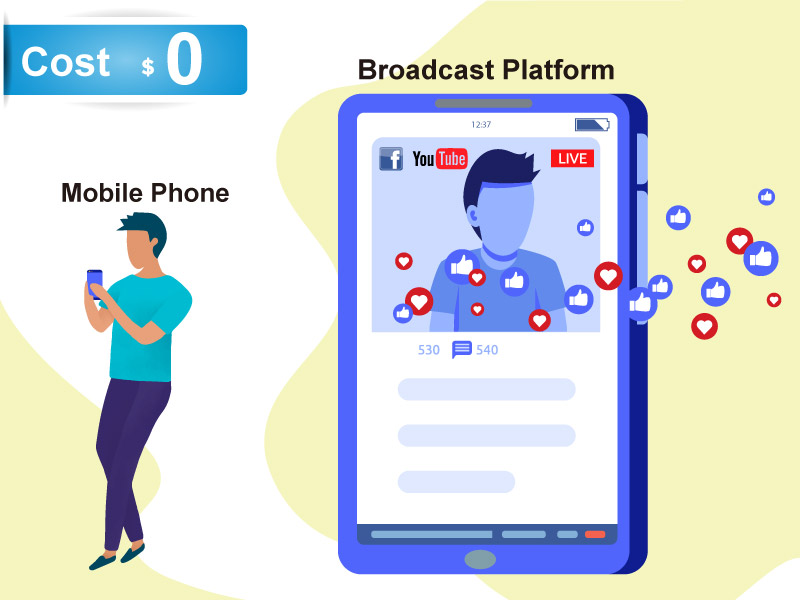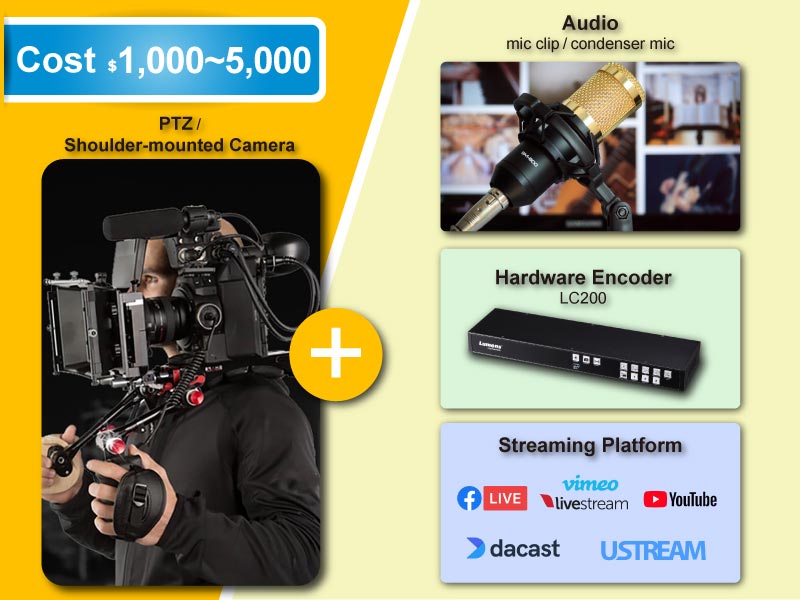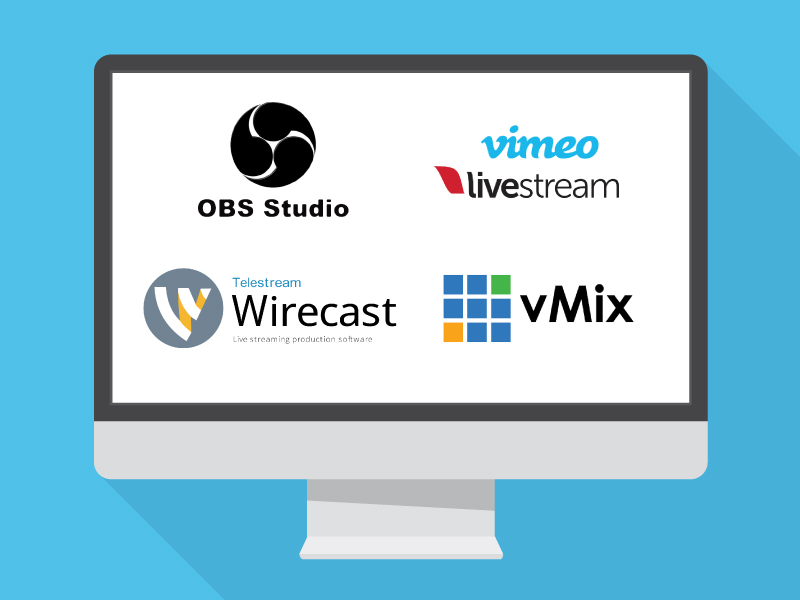【ProAV Lab】How to Choose the Right Streaming Solution for a Live Event
Lumens Editor Group
February 20, 2020 29258

Let’s say you’ve got the content, the creativity and the vision. But what if you haven’t yet made a deep dive into the technology that it takes successfully broadcast a live stream event?
The good news is there are myriad options when it comes to successfully prepping for a live broadcast stream. How do you make the right choice? It all depends on your time, your talent, your budget and your technology wish list.
OPTION 1: STARTING SIMPLE
Let’s start with the most basic of setups; think of this as a nearly zero cost scenario. For the most basic of operations, the required equipment is fairly simple: a mobile phone and a live broadcast platform. That live broadcast platform can use several well-known portals — think YouTube or Facebook — with almost no cost attached.

But keep in mind that when you go basic, you get basic. The disadvantage of this solution is apparent in both the quality of the captured image and the audio that runs alongside it. Not only will the video resolution of your live broadcast be relatively low quality, but this simple solution does little to counteract the effects of surrounding ambient noise. You’ll also be left with a production with few special effects. All that results in a less-than-thrilling stream that will be hard pressed to hook a loyal audience.
OPTION 2: STEPPING IT UP
For producers looking to create a live streaming event that goes beyond the basics, consider a second option — one that is still a relatively low-cost solution but comes with more functionality. This scenario requires four types of equipment: a camera, a microphone, a hardware encoder and a live broadcast platform.
Keep in mind that the cost for a setup like this might range from $1,000 to $5,000. Why such a wide price swing? It all depends on the features you’d like to see. Take the camera for example. Camera prices vary wildly, whether it be a single-person shoulder-mounted camera, a robotically controlled PTZ camera or a simple box camera. Audio can also be captured via a PTZ or box camera, although a shotgun, mic clip or higher-end condenser microphone will ultimately provide better audio quality.

Higher-end productions also benefit from a hardware encoder. This device can receive the camera and microphone source and process the properly encoded stream to a live broadcast platform. Typically, for smaller productions, this hardware device is small and portable. Consider options such as the Teradek VidiU standalone encoder, BoxCaster automated live streaming encoder or Digicast ProVideo streaming encoder. If you’re a newcomer just dipping your toes into the technology pool, encoders like these can be rented for a smaller fee.
These slightly higher-end productions can operate via a standard streaming platform like You Tube but you might consider other platforms — such as Vimeo, USTREAM or DaCast — which come with a fee yet provide interactive elements as well as features for video management, postproduction and marketing.
The advantage of this mid-tier solution? It’s a simple setup that can be run by a single individual. Plus, all the equipment needed for this scenario is light, small and portable. The disadvantage? You’re stuck with a single-camera stream, which can result in a relatively monotonous final production. This scenario also lacks video special effects elements. But for a video blogger putting together a personal live broadcast? This set up makes perfect sense.
OPTION 3: MOVING ON UP
What if you’re a semi-professional looking for a medium- to high-level solution? Depending on the capability of the equipment, keep in mind that your budget for this setup will range from $6,000 to $15,000.
At the heart of this set up is software. A medium-level solution like this requires a computer system, at least two cameras, professional audio equipment, broadcasting software and a live broadcast platform.

First start by taking a close look at the event you’ll be covering. Are you filming across a crowd? Will you be doing live interviews? Do you need a fixed box camera as well as a handheld POV model? Two PTZ cameras? You’ll most likely need to invest in multiple professional cameras in addition to a number of specific microphones — consider a lavalier mic for in-person interviews or a unidirectional shotgun mic to record audio across a wide ranging field.
The heart of this set up lies in the magic of encoding. In addition to the hardware encoder, software encoding also provides video mixing and video switching functionality. One of the most common tools is also a free one: OBS, an open-source software suite for recording and live streaming. There are also paid software solutions such as the vMix software video mixer and switcher, the Wirecast live video streaming production tool, and the Livestream video live streaming platform, all of which provide users with more powerful functions such as adding integrated graphics and instant replay capabilities.
The advantage of this solution is that the installation is fairly simple; almost everything is driven by your laptop computer. This setup also offers portable maneuverability, something that is important for large one-time outdoor events. Plus, today’s modern software options allow even relatively inexperienced users to build a series of broadcast-worthy special effects. And because this is a software-based system, the operation interface is highly flexible, giving users the ability to customize their interface just the way they like it.
The downsides of this scenario is tied to the computer system itself. If a personal laptop is used, you may run into hard disk capacity or CPU issues. Problems such as efficiency and network security can affect the stability of software operations in the field. In addition, software encoding generally has a longer latency when it comes to video processing (compared to a hardware encoder). Before each use, you may need to reset the software live broadcast environment, confirm whether video and audio sources are connected properly, and test their viability. Software updates and compatibility issues are also a common frustration.
OPTION 4: PROFESSIONAL GRADE
Here is the domain of large-scale organizations and professional streamers. The required equipment in this set-up is a computer system, professional cameras, audio equipment, hardware media processor, hardware encoder and a streaming platform. This high-end setup is for those looking to create a channel with multicamera presentations, overlay graphics, custom transitions, animated titles and social media integration. Be prepared for a price tag in the $10,000 to $25,000 range.
In addition to a robust computer system, several professional cameras and multiple microphone systems, this set up requires a full-fledged production switcher and hardware encoder. When it comes to encoding, professionals should consider a higher-end hardware encoder that will provide a stable transmission rate, shorter latency issues, and multiple input and output interfaces.
The benefits of this solution are obvious: top of the line video/audio quality and ease of use. Each device in the chain is designed for a specific function so quality and stability are constant. The operating interface of the hardware unit is also likely to be simpler than that of its software sibling. If this production is set up in a fixed auditorium environment, the subsequent live broadcast workflow is a repeatable and automated process too.
The obvious downside? This solution is a bit more costly. Plus, you’ll need to ensure compatibility between the devices. In addition, the installation and wiring of the device for the first time may need to be guided by a professional system integrator, although the modern pursuit of the plug-and-play concept and the trend of AV over IP means that manufacturers are more successfully addressing the longstanding difficulty of new hardware installations.
OH, AND DON’T FORGET
No matter which scenario you choose, Internet connection is of utmost importance. Wired connection has long been seen as the most stable method of transmission with a recommended upload speed of 3-5 Mbps. Consider, too, network bonding technology, which can combine two or more network interfaces into one to increase bandwidth. While wireless connection is a backup option, it is not optimal for any high-quality video stream — it can be easily impacted by distance and nearby networks using the same wireless frequency (2.4GHz / 5GHz).
So how to choose? Consider your budget. Think about your audience. And then set your long-term goals when it comes to covering live streaming events. The good news is that there are options for all.
.jpg)
